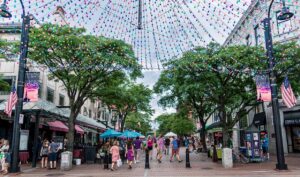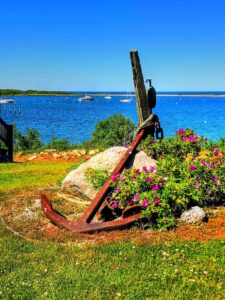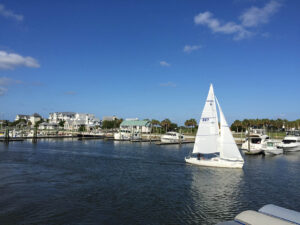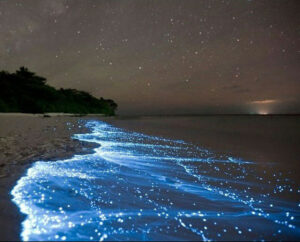Imagine cruising through unfamiliar waters without your GPS sonar, nautical navigation charts or even electricity. That’s what Colonial-era ship captains faced while sailing through the Chesapeake Bay. Its jagged coastlines, treacherous shoals and unpredictable forces of nature created a harrowing experience for sailors who only had buoys in the water and signal fires on land to keep them out of harm’s way.
As Bay shipping traffic swelled in the 1700s, George Washington understood that safely transporting people and goods was paramount to the fledgling nation’s growth and commerce. Making sure vessels could come and go out of essential ports such as Baltimore, Annapolis, Alexandria and Norfolk became a pressing issue, so in 1789 the U.S. government took charge of the American lighthouse system. In 1792, the 90-foot tall Cape Henry Lighthouse at the mouth of the Bay in Virginia became the first to shine its light on Chesapeake waters.
By the early 1800s, these beacons of safe passage sprang up all along the Maryland and Virginia shores, thanks to master builders like John Donahoo of Havre de Grace. He is credited with constructing dozens of lighthouses from 1823 to 1853 and guiding millions of travelers through perilous channels.
Man Versus the Beastly Forces of Nature
By 1900, most of the Bay’s danger zones were marked with warning beacons. At the peak of construction, 70 lighthouses dotted the coastline, each with distinct histories and designs.
The early ones were lofty towers made of brick or stone and were erected on land. Modest homes for lighthouse keepers stood nearby. Examples include Old Point Comfort, Cape Charles, Point Lookout and Cove Point lighthouses. It was a good start, but soil erosion under the towers posed a problem and caused some to collapse or be moved. Plus, these lighthouses were located above the water where dangers awaited cautious ship captains.
To address those logistical problems, screwpile lighthouses were developed. From 1854 to 1900, 42 of this design were erected – more than anywhere else in the world – and they became a symbol of Chesapeake maritime ingenuity. Screwpile lighthouses were two-story buildings with seven or eight sides, the beacon on top and iron piling legs that were screwed into the Bay’s soft muddy floor. Lighthouse keepers and their families lived on the second story. Examples: Thomas Point Shoal, Drum Point and Hooper Strait lighthouses. They were positioned in the water to better aid passing ships, and massive rocks were piled around the base to secure their spidery legs. However, this type of lighthouse struggled to hold up against the Bay’s pounding waves, ice chunks and high winds. One screwpile structure was blown off its platform during a ferocious storm with the keeper inside and floated for five miles before he could escape.
Undaunted by Mother Nature’s powerful forces, determined maritime architects came up with a new solution — the caisson lighthouse. From 1873 to 1914, they designed lighthouse foundations with cast iron cylinders filled with stones or concrete and drilled them deep into the Bay’s bottom. With a top tower built of brick the caisson style evolved into sturdy structures that could withstand rugged Chesapeake conditions. They might not have as much curb appeal, but most of them have survived since the 1890s. Examples: Wolf Trap, Sandy Point Shoal, and Smith Point lighthouses.
Last but not least was another resourceful means to beat the precarious elements and offer
travelers safe passage around the Bay — lightships. The first of these warning vessels was built in 1820 in Virginia. They could move into deep waters and withstand harsh conditions that land-bound lighthouses could not endure. Plus, they could scurry away if situations became to rough. The Lightship Chesapeake is retired from her call of duty and now entertains guests in Baltimore’s Inner Harbor.
Step Back in Time and Experience Chesapeake Heritage
Sailing past Chesapeake lighthouses on land or sea is always a thrill. Climbing inside these magnificent structures is even better. The places listed below are home to decommissioned Bay lighthouses and lightships, which are now interactive living museums about a bygone era. For a day, you can live the lonely life of a lighthouse keeper and experience his close quarters above the waves.
- Chesapeake Bay Maritime Museum (St. Michaels, Md.) – 1879 Hooper Strait Lighthouse
- Cape Henry Lighthouse (Fort Story, Va.)
- St. Clements Island Museum (Coltons Point, Md.) – Blackistone Lighthouse
- Calvert Marine Museum (Solomons Island, Md.) – Cove Point and Drum Point Lighthouse
- Baltimore Marine Museum (Baltimore Inner Harbor) – Knolls Seven Foot Knoll Lighthouse and Lightship Chesapeake
- Smithfield Station Lighthouse Inn (Smithfield, Va.) – This isn’t a real lighthouse, but it’s the only place on the Bay where you can actually spend the night in one.





